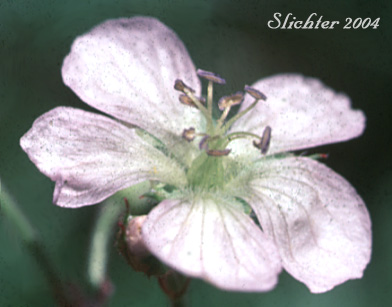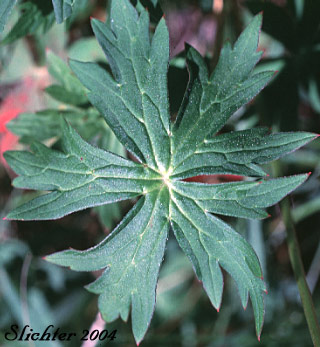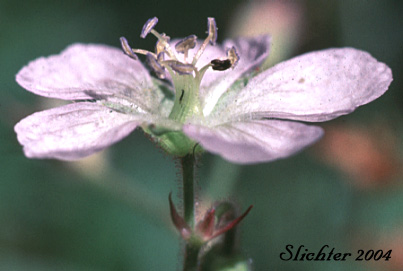

 The
photo at right shows the simple, palmately veined leaf of Richardson's geranium
as seen in the Bob Marshall Wilderness of Montana........July 27, 1999.
The
photo at right shows the simple, palmately veined leaf of Richardson's geranium
as seen in the Bob Marshall Wilderness of Montana........July 27, 1999.
Also known as Richardson's crane's-bill, Richardson's geranium is an attractive hardy perennial wildflower suitable for the wild garden. Plants are short-rhizomatous from a taproot with numerous erect to spreading stems from 30-70 cm high. The herbage of the lower stems ranges from glabrous to covered with numerous down-pointing hairs t covered throughout with gland-tipped hairs. The leaves are simple with palmate venation, the blade deeply incised into 5-7 large divisions (See photos.). The blades are 6-12 cm wide with the petioles of the lower leaves from 5-15 long.
The inflorescence consists of 2 to several flowers in an open cyme. The peduncles and pedicels are densely pubescent or covered with gland-tipped hairs. The glands are often reddish or purplish. The pedicels range from 1-3.3 cm long while each of the sepals is ovate in shape and 6-10 mm long. The petals are broadly oblanceolate to obovate in shape with rounded tips. They are white or pink with purple or dark reddish veins and measure from 11-18 mm long. The inner surface of the petals are densely covered with long, soft, straight hairs over the lower half of the petal. The mature stylar column is 21-28 mm long. The stylar column consists of the elongated style with the closely appressed stamens which only diverge from the axis of the style at the anthers. The tip of the style is divided into 5 short, spreading stigma lobes.
The similar sticky geranium (G. viscosissimum) has petals that are pink, lavender or violet with purple veins. They are covered with long, soft, straight hairs over the lower quarter of the inner face of the petal. This geranium is more often found in drier, more upland habitats while Richardson's geranium is found in moist, shady places along streams and seeps. The two species appear to intergrade where their distribution meets.
Richardson's geranium may be found growing in moist, shady riparian areas near streams and seeps.
Richardson's geranium may be found from eastern British Columbia south to the east of the Cascade Mts. to southern California and east to the Rocky Mts. and south to Arizona and New Mexico. The species is not common in Nevada or western Utah.
